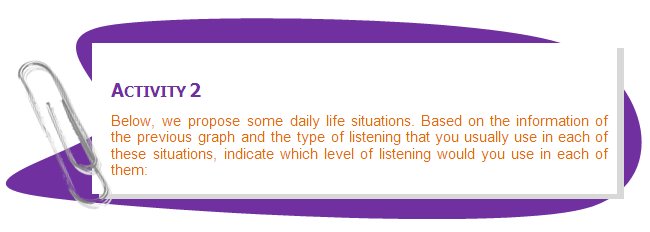Key Competencies Kit
for Facing Lifelong Learning


 |
This Project has been funded with support from the European Commission. This communication reflects the views only of the author, and the Commission can not be held responsible for any use which may be made of the information contained therein. |
 |
Upon completion of this unit you shall be able to:
If you reflect upon your communication habits you shall realize that, with more or less frequency, you jump to wrong conclusions, focus more on what you are saying than what other people is saying, get distracted thinking about other things, don’t provide the other person with feedback…
Many of the communication problems that we have are related with our bad habits regarding listening. We tend to think that being equipped with two ears it’s enough for listening, however this idea might be absurd, as it is like thinking that just because we have two eyes we know how to read.
You probably remember the time of your life when you were taught how to write and read, and you could also tell us how to help a child to acquire the language. Yet, in your life, has anyone taught you how to listen?
You shall realize that there is a clear contradiction, on the one hand we are stating that listening is a very important communicative skill and, on the other hand, you can verify that this skill has never been properly taught to you in all your life.
The skill of listening shall have a great impact in your personal and professional development, therefore, it’s time to train you on this skill and to implement appropriate listening skills.
First, we want you to reflect upon the following questions:
Do you think that hearing and listening refer to the same action?. Justify your answer.
When you are having a conversation. Do you devote more time to speak or to listen?
What do you think “active listening” means?
In Unit 1 we referred to how people distribute their time when communicating. Can you remember the percentage of time that was devoted to listening?
As you already know, communication is an information exchange process between several people. The fact that during the communicative process there is an exchange of information implies that it is a reciprocal process that provides two-way feedback.
What do we mean when we use the term “feedback”?
Imagine that you are telling a work peer about your summer vacations. You are providing him with details on the places that you have visited, about the people that you have met...and he won’t look at you, he won’t say anything, he even turns his back on you and keeps on doing his work. You shall most probably think that this person is not listening to you and you shall stop talking.
Obviously, in this case we would not talk about communication, as there is no answer or feedback from the other person.
When we communicate, we all need to verify that our interlocutor is listening to us, in other words, we need feedback or answers that allow us to verify that the communicative process is properly being developed and that we can continue developing it.
However, sometimes we forget to provide answers or signs of our being listening, sometimes we even forget to listen and this affects the proper development of the communicative process.
As we have already told you, listening is one of the most important and most difficult elements of the communicative process. We tend to focus more on what we say than on what others say, thus loosing the essence of communication: Sharing information
In the previous situation we can state that your peer is hearing you but not listening to you. In other words, there is no doubt that your peer is perceiving sound vibrations, but he is not processing, interpreting and/or understanding the information that you are sending him.
The terms “hearing” and “listening” refer to two different concepts:
|
 |
In order to listen it is necessary to hear, although the act of hearing does not necessarily imply listening. |
We could say that when we listen we are moving a step forward, we hear the sounds sent by our interlocutor, but, in addition, we interpret them, evaluate them and assign a meaning to them, etc.

If you think of examples of situations of your daily life where you need to use the skills of “hearing” and “listening”, you shall realize that most times we start listening but, as the communicative process moves forward we tend to switch to the action of hearing. Depending on the circumstances of the communicative process we can identify several levels of listening.
Have a look at the following graph:
Listening levels thermometer |
|
|
Active listening: I listen paying attention to verbal and non-verbal elements. |
Verbal listening: I listen paying attention to words, but I don´t rely on non-verbal elements. |
|
Competitive listening: I listen but I constantly interrupt, as I am more interested in speaking. |
|
Disconnected listening: I seem to be listening, but only my body is taking part in the communicative process. |
|
Hearing: Sounds reach my ears, but I don´t interpret them. |
|

In the classroom, your teacher is explaining how to carry out the practical activities:
A bank clerk is providing you instructions about the documents needed to apply for a credit card:
You are attending a community of residents’ meeting:
You attend a concert of your favourite band:
A relative of yours is explaining to you the treatment that he/she has been prescribed by his/her doctor:
You discuss with a friend about the raise of the price of tobacco:
You attend a conference on the Discovery of America:
You listen to a football match on the radio:
As you have probably verified, your level of listening varies depending on several factors: The subject being discussed, the relationship with your interlocutor, the environment, your mood, the length of turn, etc.
We have seen that there are several levels of listening, that might change depending on the situation; and even in the same situation, they might change depending on the moment. In general we can refer to:
|
 |
Active listening allows us to take an active part in the communicative process and contribute to its proper development. This type of listening provides the necessary “feedback” that we have already mentioned. |
In the introduction of this Unit we asked you what you understood by the term “active listening”.
 |
You already know that listening means understanding or interpreting what is being heard. If we combine this concept with the adjective “active”. What do you think it would mean? We provide some clues that might be very helpful:
|
Based on these clues, try and develop a definition for Active Listening:
Active listening refers to the ability to listen with the attention and concentration needed to understand not only what someone is expressing directly, but also the emotions, ideas or thoughts that underlie what is being said. |

|
Necessary… |
Not necessary… |
|
|
|
|
|
|
|
|
|
|
|
|
|
|
|
|
|
|
|
|
|
|
|
|
|
|
|
You already know the difference between hearing and listening, you are also able to describe the different levels of listening and you can also explain what we mean when we use the concept active listening.
It is time to assess your command of the ability of listening. In order to do so, fill in the following questionnaire to assess your ability of active listening:

|
YES |
NO |
If I realize what the other person is about to ask me, I don’t anticipate the question and I wait for the other person to finish speaking before answering. |
|
|
When I answer someone’s question, I do it according to the way that I perceive they feel.... |
|
|
I think that most people don’t like being interrupted when they are speaking. |
|
|
In general, I try to focus on what the other person is saying and how it is being said. |
|
|
If someone is having trouble to tell me something, I generally help him/her express himself/herself... |
|
|
While I am listening, I say things like “Yes, yes…sure”, “I understand…” to let the other person know that I am paying attention... |
|
|
If I don’t understand what the other person is saying, I pose the necessary questions to understand what is being said. |
|
|
If you are talking with someone and your telephone rings, you wait until the other person has finished talking before answering the phone. |
|
|
I can remember details of my interlocutor such as colour of the eyes, facial gestures, clothes that he/she is wearing, etc. |
|
|
When you are talking to someone, you avoid playing around with objects, thinking about other subjects, etc. |
|
|
You can see the assessment of your answers in the solution of activities section.
 |
Which assessment have you obtained in the previous questionnaire?
Do you think that this assessment is realistic?
Can you indicate any aspect that you think you should improve when listening?
|
The previous questionnaire has probably provided you with a hint on the quality of your listening skill. Obviously, up to a certain extent, we all have strengths and weaknesses that we put into practice when listening.
Read the following dialogues and identify the elements of conversation that support active listening:
|
Psychological disposition, this means, preparing oneself to listen to someone. |
|
Letting the other person know that you are listening. In order to do so, use verbal communication (I see, oh, etc.) and non-verbal communication (eye contact, gestures, body posture, etc.)
|
However, there are also other elements that hinder active listening, analyze the following dialogues:
|
Distractions. The attention curve starts out very high, it decreases as the message moves forward and increases again towards the end of the message. We must look after our level of attention, especially halfway of the conversation. |
|
Interrupting the person speaking |
|
Make a judgement of the person who is speaking. |
|
Offer untimely help or solutions. |
|
To disregard the feelings of your interlocutor. |
|
Tell “your story” when the other person is trying to tell his/her story. |
|
Contradict continually. |
|
To have a solution for the other person’s problem, even before he/she has explained the problem (“Expert’s Syndrome”). |
As you have seen in the previous situations, it’s easy to make mistakes when listening, due to such mistakes the communicative process is eventually interrupted, prematurely finished, misunderstandings occur, etc.
 |
What mistakes do you most often make when listening?
How do you think you could solve these problems?
|

The members of the group must form pairs. Each member of the pair must choose one of the following roles: Sender or Receiver.
All pairs must role-play the following situation:
The sender phones his friend (the receiver) at 3 a.m. and asks him to meet as soon as possible in a bar in his neighbourhood to tell him about a serious problem. The sender must make up a serious problem that shall be transmitted to the receiver.
You must role-play this situation in pairs, while the rest of the group watches.
The teacher shall provide each receiver with guidelines as to what must be his/her listening attitude towards the problem explained by the sender. The receiver must follow these guidelines along the conversation that takes place in the bar.
The remaining members of the group must identify elements in the receiver’s listening that hinder the communicative process during each role-play.
 |
How do you feel (as receiver or sender) when you are not listening or feel that you are not being listened to?
Do you think that the situation proposed required active listening?
Have you ever experienced a similar situation?
|
In the previous section we have seen some elements that support listening, as well as other elements that hinder it. As you have seen, to show an active listening attitude is no always easy.
Now we shall try to find out some of the basic guidelines that can be very helpful if applied for active listening.

|
Active listening: YES NO Justification: The receiver puts himself/herself in the place of the sender. |
|
Active listening: YES NO Justification: ………………………………………………………. |
|
Active listening: YES NO Justification: ………………………………………………………. |
|
Active listening: YES NO Justification: ………………………………………………………. |
|
Active listening: YES NO Justification: ………………………………………………………. |
 |
Do you usually apply the active listening techniques that we hace been in the previous situations?, In which situations?
Which techniques do you think are the most helpful to support communication?
|
When using active listening is useful to apply some of the following techniques:
|

The teacher would play a recording of a piece of news broadcasted on the radio (or he/she would read a piece of news published on the press. Each of you must write down in a piece of paper:
What has happenned?
Whan has it happenned?
Who was involved?
Where has it happenned?
Then, the teacher shall show you the news once again.
Are there any differences between your answers and the actual news?
|
 |
You shall repeat the activity with another piece of news. Each of you must answer the same questions again:
What has happenned?
Whan has it happenned?
Who was involved?
Where has it happenned?
Now you can apply any of the active listening techniques that you know (paraphrasing, using support words, using explanatory expressions…) to tell the news to your teacher.
 |
Are there any differences between your answers and the actual news?
Are there any differences between applying active listening techniques or not using them? |

 |
Response to issues and activities outlined in the Didactic Unit 3 |
Below we propose some examples of daily life situations where we put into practice the abilities of “hearing” and “listening”:
Examples of “hearing”:
When we are driving and the car radio is on, sometimes we listen to what is being said, but most of the time we are just hearing the sounds that are being broadcasted (especially in cases like this, where we are carrying out another activity).
When we attend a conference on a subject that we don’t care about, we might start listening what the presenter is saying, however, as time goes by, we tend to disconnect and we just hear the words being said.
When we are walking on the street, we hear many different sounds (car engines, people talking…), however, just a few sounds call our attention so that we don’t only hear them, but also listen to them.
Examples of “listening”:
When we phone a friend to ask him how was everything on his first day on a new job.
When someone is giving us directions as to how to get to a certain place.
When we are watching a movie, we listen to the conversations between the main characters, thus we can follow the development of the story.
The levels of listening that you have assigned to each of the situations suggested shall vary depending on several aspects: The subject being discussed, the relationship with your interlocutor, the environment, your mood, the length of turn, etc.
What is important is that you are aware of the differences between the different levels of listening, and especially of how they affect the proper development of the communicative process.
The chart with the characteristics that define active listening should be as follows:
Necessary… |
Not necessary… |
|
|
X |
|
|
|
X |
|
X |
|
|
X |
|
|
X |
|
|
|
X |
|
X |
|
|
|
X |
|
X |
|
In order to assess your ability of listening, you need to count your positive answers. Then, you must choose the score that corresponds to the number of positive answers:
Count the number of affirmative answers and reflect upon the score that you have obtained:
Between 10 and 8 affirmative answers. Congratulations! You are an excellent communicator and user of “active listening”. With your abilities you are able to listen to the person that is speaking, putting yourself in his/her place, interpreting the information that you are receiving and helping him/her feel listened to and understood. You often use the level of empathic listening.
Between 7 and 5 affirmative answers. Cheer up! You often use the ability of “listening”, but sometimes you relax and use other levels of listening such as verbal listening and competitive listening. We encourage you to improve your ability of active listening, and you can very easily improve.
Between 4 and 3 affirmative answers. You need to improve! No doubt your usual procedure is disconnected listening, in other words, it seems that you are listening but, actually, your mind is elsewhere. You need to train in order to move up to higher levels of listening and to get closer to active listening.
Between 2 and 0 affirmative answers. Wrong! You are on the wrong track. Your manner of listening really hinders the communicative process. You have the habit of hearing, but you haven’t been able to move forward towards listening. You need to take measures as soon as possible. You need to improve your ability of listening immediately.
Below you can see our assessment of the use of active listening in the following situations:
|
Active listening: YES NO Justification: The receiver puts himself/herself in the place of the sender (he/she empathizes with him/her). |
|
Active listening: YES NO Justification: The receiver follows what the sender is saying and verifies that what he is understanding is correct (paraphrasing). |
|
Active listening: YES NO Justification: The receiver encourages the sender to communicate (reinforcing communication). |
|
Active listening: YES NO Justification: The receiver synthesizes the information received (summarizing). |
|
Active listening: YES NO Justification: The receiver clarifies the information received (making questions). |